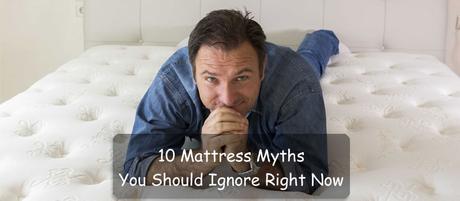Here are 10 mattress myths you should ignore right now! Mattress myths are ten a penny online, and they may not only be confusing to many people but can also lead you into buying a mattress that is not suited to your needs. Here is our penny's worth - the full 10 so you get value for your penny, which is more than you will get if you heed these myths and buy the wrong mattress.

1. You need a Pillow-top mattress to get you the best comfort
Total nonsense! Sure, pillow-top mattresses may be comfortable, but so are many others without them. A pillow-top simply gives the mattress a plush feel - a feeling that you can get with many other types of mattress. If you want extra plush, then get a pillow-top or cushioned mattress topper to lie over a good, well made mattress.
Some 'pillow-top' mattresses are fabricated using a soft fluffy cushioned top to hide the inherent lack of support or integrity of the mattress. It may feel plush to lie on, but your back may complain a few weeks or even days down the line. A good mattress must provide support where you need it, and most do.
The top is less important that the way the mattress is constructed. A good, solid central core is important for core support. Over that, or integral with it, should be a layer with sufficient support to enable your whole spine to be supported, not just at your hips and shoulders. Otherwise, issues with your lower back (lumbar region) may eventually develop. Your pillowtop can go over that in the form of a mattress topper that can be removed when necessary.
2. A hard mattress foam is the same as a dense foam
Wrong! The density of any substance is how much a specific amount of it weighs. Density is mainly quoted in terms of grams/per cubic centimeter. For foams, it is Kg/cubic meter. That is the weight of a cubic meter of that foam. Some foams are denser than others, and it only a passing equivalence to hardness. Some foams are harder than others irrespective of their density
The hardness of a foam is measured by compressing it. It is the force needed to compress the foam by 40%. This is a much more relevant measurement than density where mattresses are concerned. You are more interested in how the foam reacts when you lie on it than on how much foam there is.
Too hard a foam might not support your spine in the small of your back - where it naturally curves inward. That can cause back problems later. A softer foam can support your entire spine while still allowing it to retain its natural curve. This is not necessarily true with more or less dense foams.
3. A hard mattress is best for a bad back
No! Many people believe that the harder the mattress, the better the support. It makes sense to a certain extent, but not if you understand how your spine curves from your neck to your coccyx right at the base of your spine. Your spine takes a natural 'S' shape as you grow. The thoracic curve, from your shoulder to your hips curves inwards. Your spine is shaped that way so it acts as a spring: it is flexible when under pressure.
Look at your spine straight on from your back and it seems straight. Look at it from the side and it is curved. When you lie on a hard mattress, the curve of your back is unsupported. The mattress will support your shoulders and hips/buttocks, but not the middle part of your spine. That will tend to sag down, put pressure on your vertebrae and lead to back pains.
A hard mattress may suit you if you always sleep on your side, but otherwise - no. You need a mattress that supports your shoulders, hips and feet, but also the small of your back. A hard mattress is fine if you sleep with some support, such as a pillow, under your back, but very few do. A medium firm mattress is better than a soft mattress, and memory foam mattresses tend to be best for back sleepers.
4. You must have a box spring base
This is another of those mattress myths you should ignore. A suitable mattress for your weight should support you without a box spring base. The box spring is better than a slatted base, but so also is a solid wood base. Allow the mattress to provide the support. In the 'old days' mattresses were thinner and more basic than they are now, and the box spring was used to provide some spring and to absorb shock. Modern mattresses have no pressing need for a box spring.
5. Mattresses cannot be cleaned
Many people believe that mattresses can't be cleaned. This may have been the case a century ago, but not now! Mattress can be cleaned, and how it is cleaned depends on the type of mattress you have. Any mattress can withstand a regular vacuum. This removes any loose dirt and dust (generally skin cells and dust mites) and keeps your mattress healthy to lie on.
A steam cleaner is also a good way to clean a mattress if you leave it to dry before using it. So don't steam clean your mattress in the evening unless you work nights! However, you can minimize the need to clean a mattress by using a mattress topper. These are available in a range hardness levels, from soft and plush to firm. They also absorb spillages and are less expensive to replace than the mattress. Many are machine washable.
6. A quick lie down in the showroom is all the testing needed
Nonsense! You need longer than that. After getting up, having breakfast, traveling to the store and looking around, almost any mattress will feel comfortable! You need to use a mattress for several nights before coming to a conclusion. But how do you do that? Many mattress providers selling through offer a free trial period - up to 120 nights and sometimes more. Buying from Amazon can provide you with a good trial for your mattress.
7. One mattress suits both you and your partner
That is true if you are both the same weight and don't move about much when sleeping. A 140 pound woman and her 200+ pound husband or partner need different mattresses. There are two options: fit two single mattresses on a king size bed or buy a mattress that separates each partner.
Innerspring mattresses with individually pocketed coils can achieve this to an extent. However, for fairly significant weight differences, your best choice would a memory foam mattress. Memory foams soften according to the pressure and heat of your body. That means that the area of the mattress used by each partner conforms to their individual frames without significantly affecting the other.
8. Mattresses should be flipped and turned regularly
Many people believe that they should flip and turn their mattress regularly to keep it comfortable. This may not be the case. For a start, most modern mattresses are one-sided so you can't flip them. However, you may find it helps to turn or rotate your new mattress monthly after purchasing it. If you do this for around six months, then for every three months after that, you should get the best wear and performance from it.
Expect to see your mattress forming an impression where you sleep - that is not a fault with the mattress. This is less likely to be obvious if you rotate your mattress twice a month for the initial two months after purchase. Flipping your mattress only helps if both sides are the same.
9. You can remove dust mites by washing your sheets
Dust mites are bad for those allergic to them. They live on your dead skin cells, so mattresses are an ideal habitat for them. Washing your sheets might remove dust mites from the sheets, but most live within the mattress itself. An innerspring mattress can harbor zillions of dust mites. Steam cleaning the mattress can help - but only to an extent.
If you have an allergy to them, the best way to protect yourself from dust mites is to use a washable mattress protector on top. Then you can wash this regularly to remove any dust mites present. Washing also removes the skin cells on which they feed.
10. Mattress warranties or guarantees are ironclad against faults
We wish this were the case! A 5 or 10-year warranty, or even a so-called 'lifetime warranty', does not normally refer to the mattress. Read it carefully and you may find that it likely involves the materials the mattress is made from. Many warranties are invalidated if you wash any topper provide or try to clean the surface of the mattress.
The mattress must be in exactly the same condition as it was supplied - so why would you need to use the warranty? Make sure that you check the details and conditions of any warranty offered. You may find that by cleaning up a baby's sick from your mattress you have invalidated the warranty!
10 Mattress Myths: Conclusion
These are our 10 mattress myths that you should ignore right now! In fact, that terminology is just as confusing as the information and warranties that come with many mattresses! You should not ignore these 10 mattress myths but study them closely. Then you may be better armed with the facts that can help you choose the right mattress for you - and your spouse or partner.
Keep Reading: Is Sleeping on A Mattress on The Floor Bad For You? "

